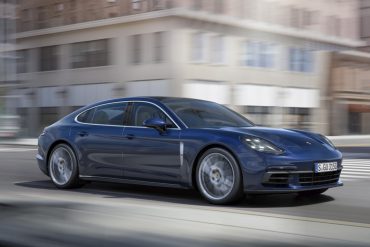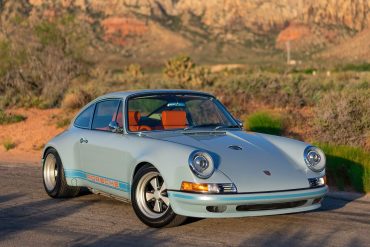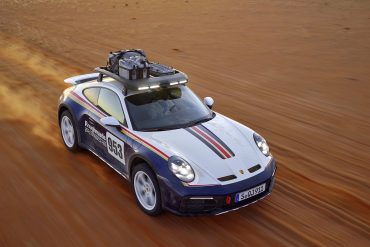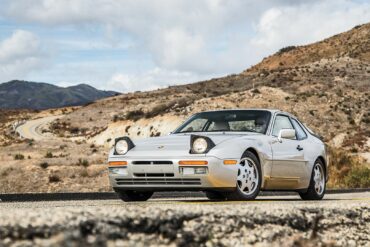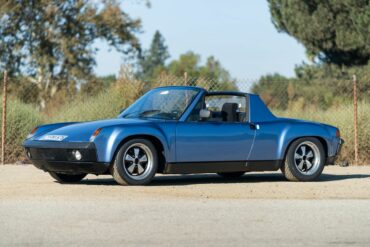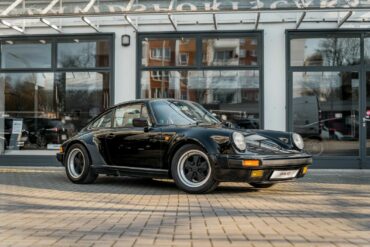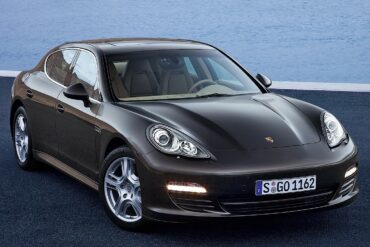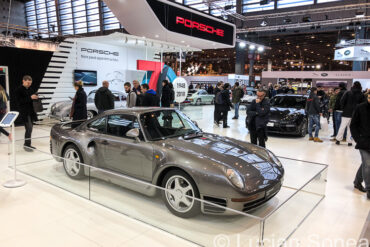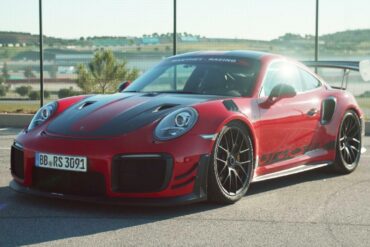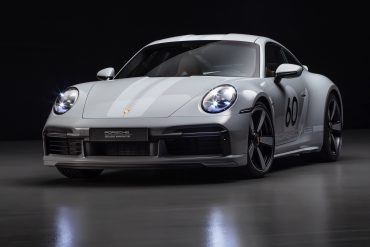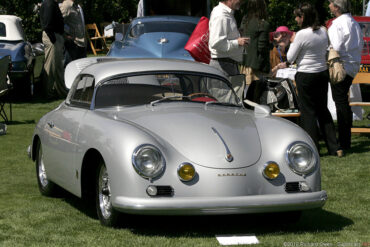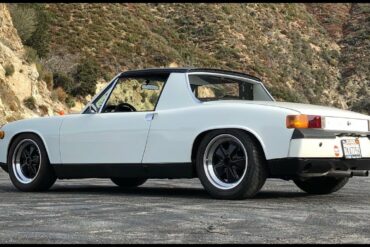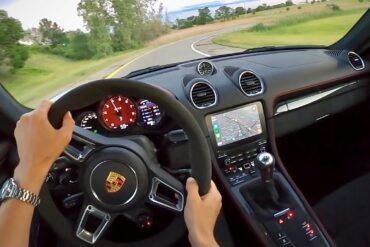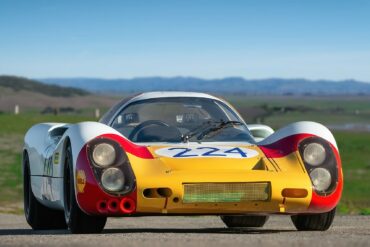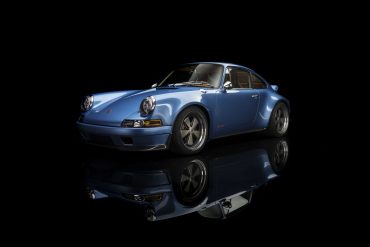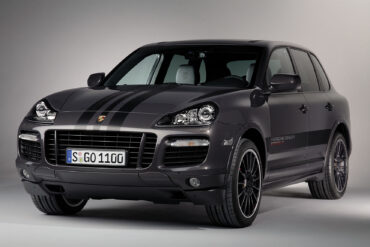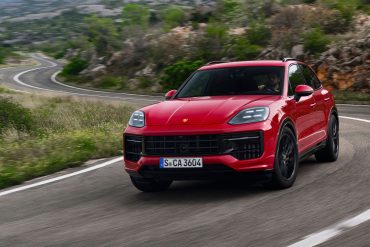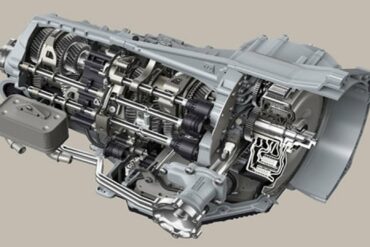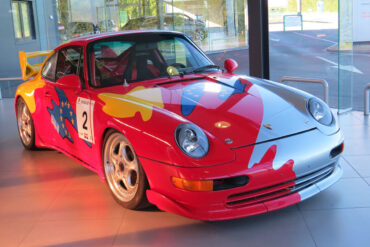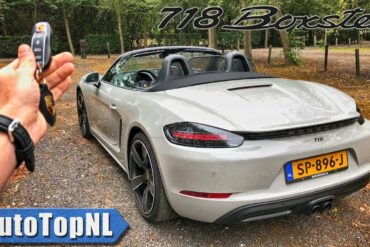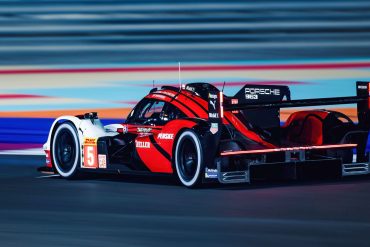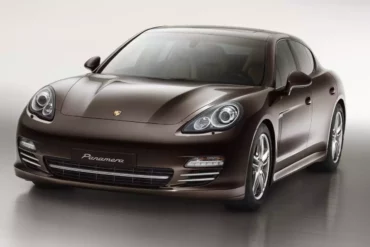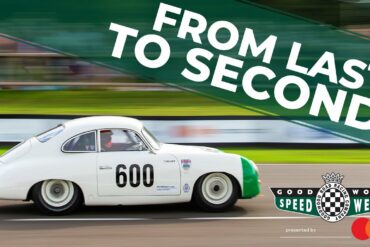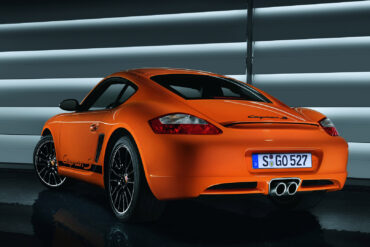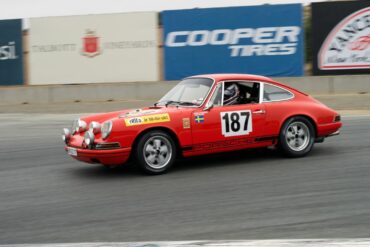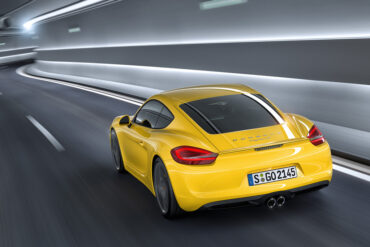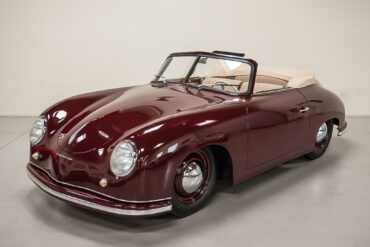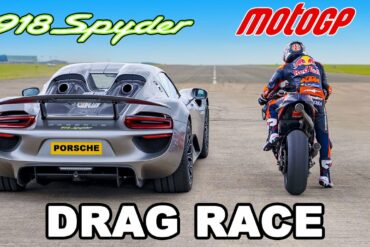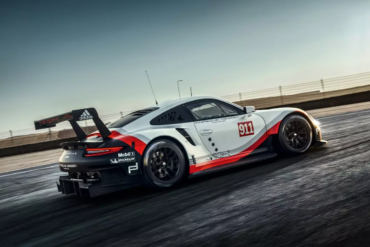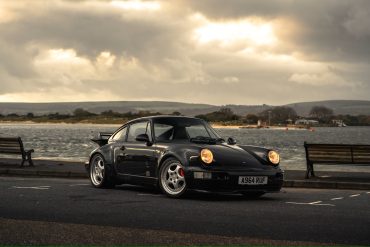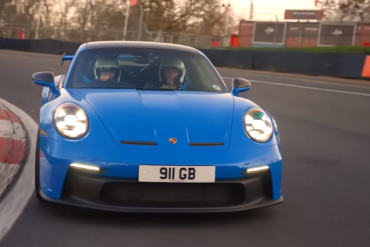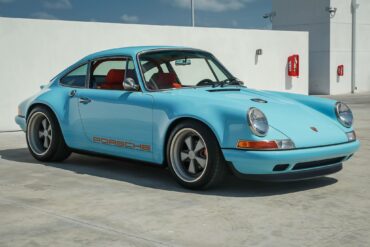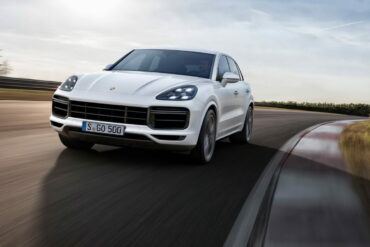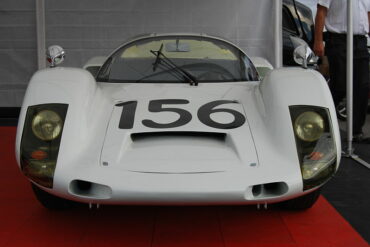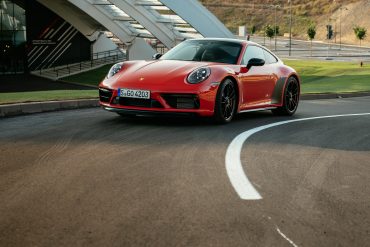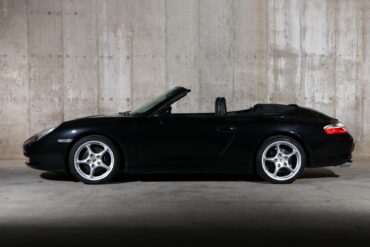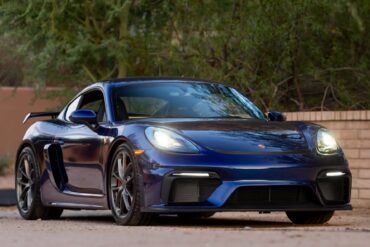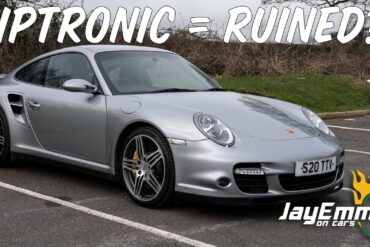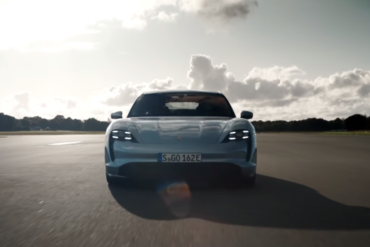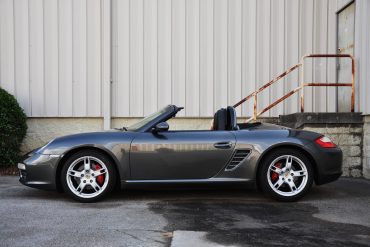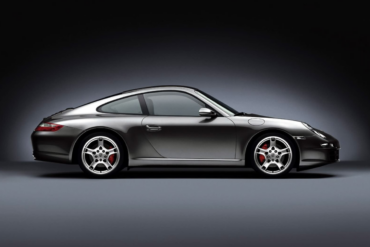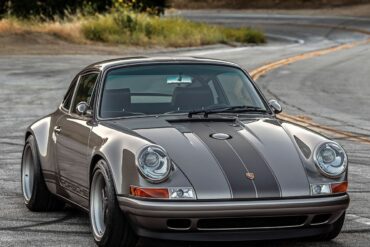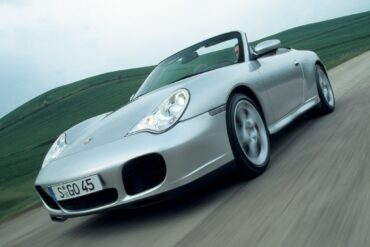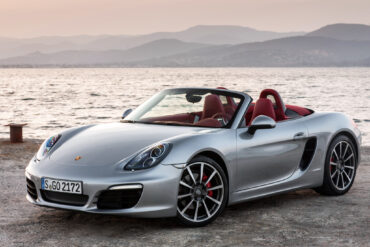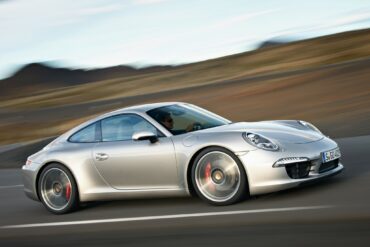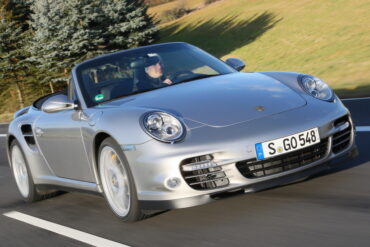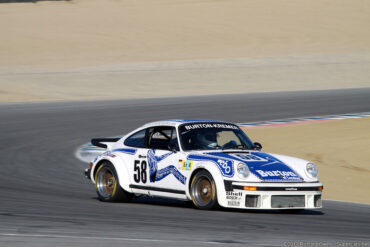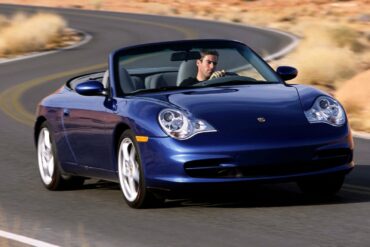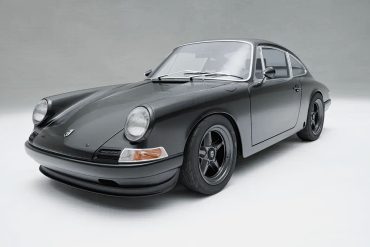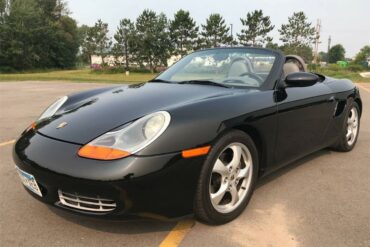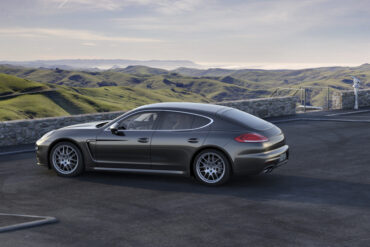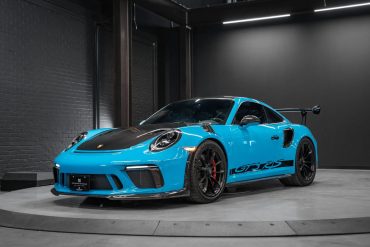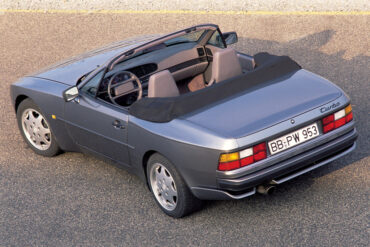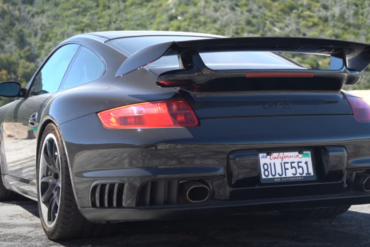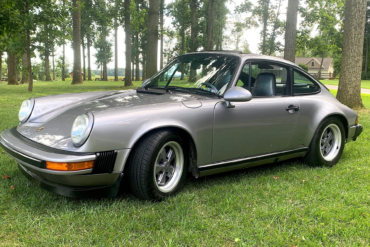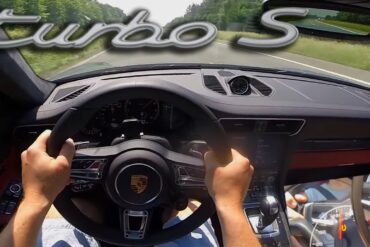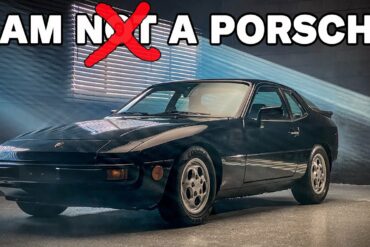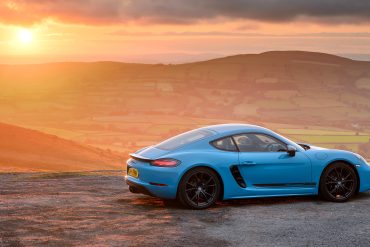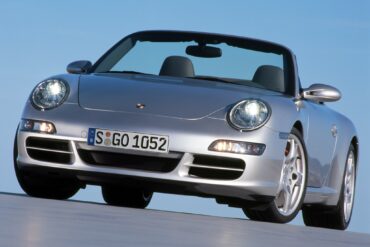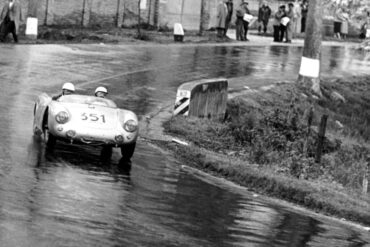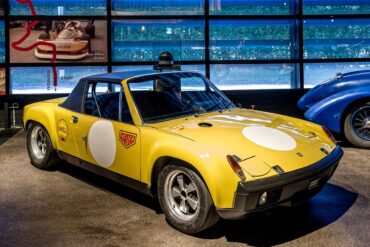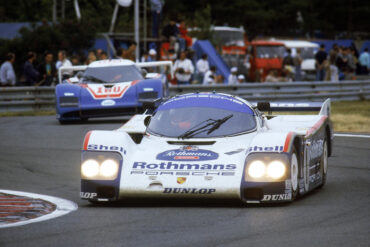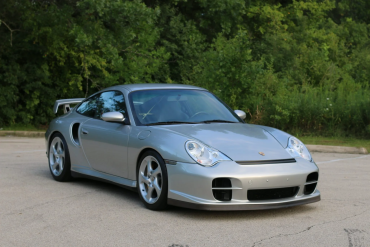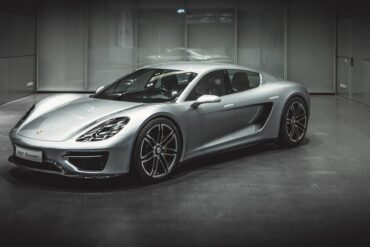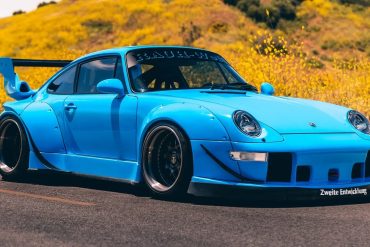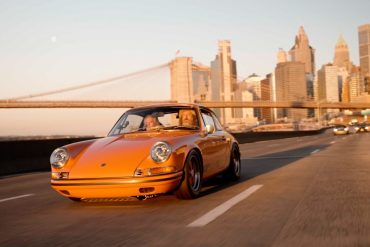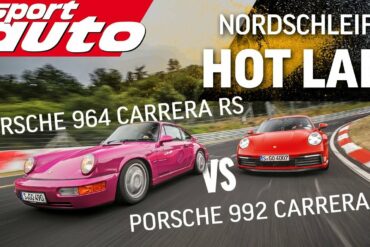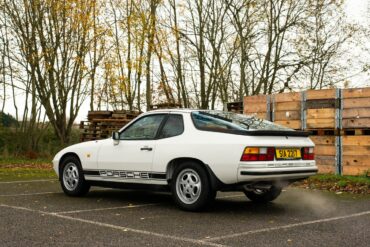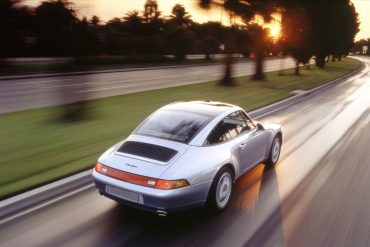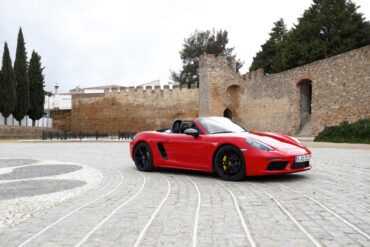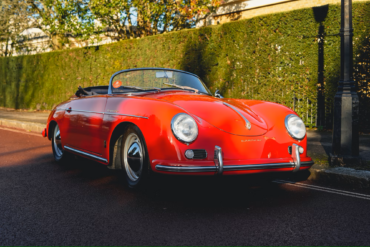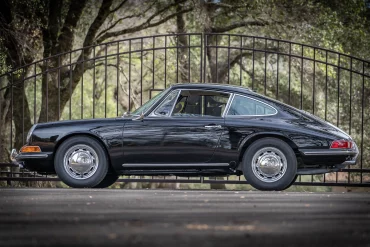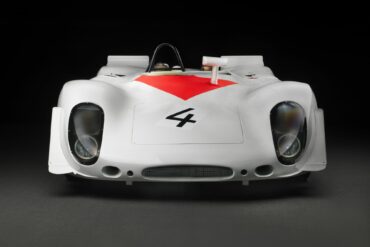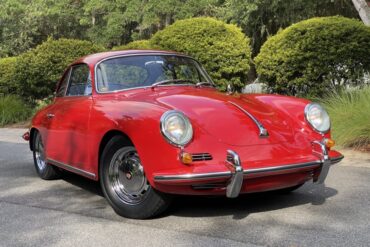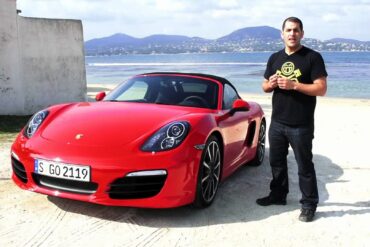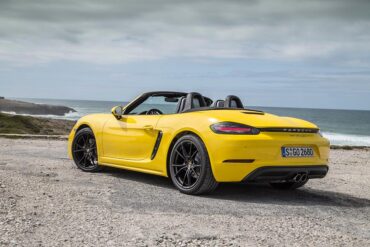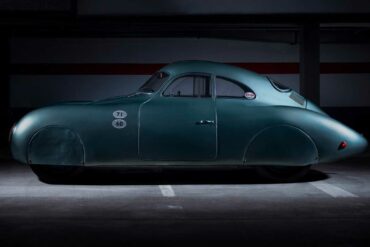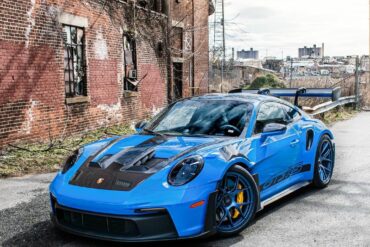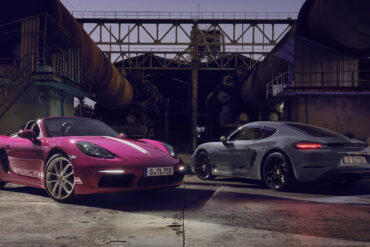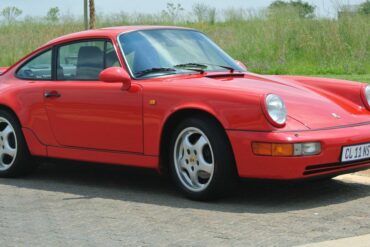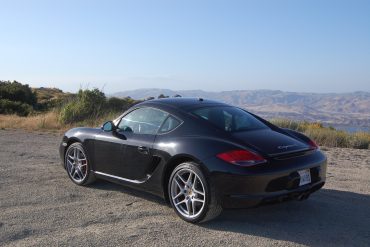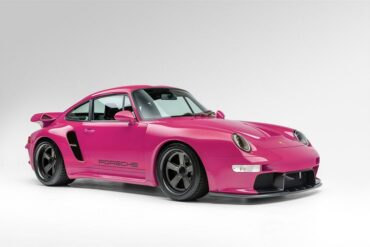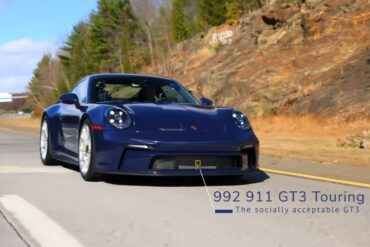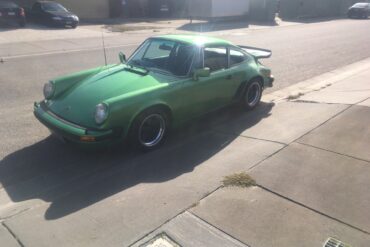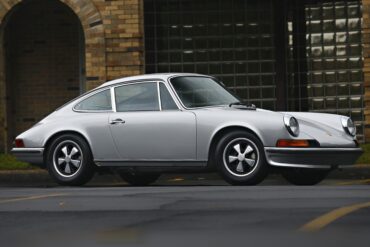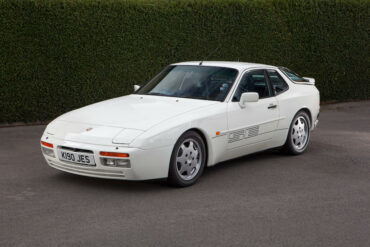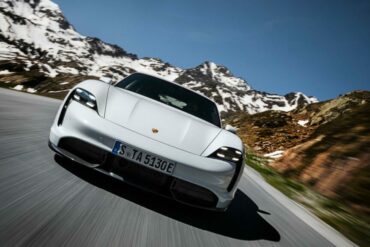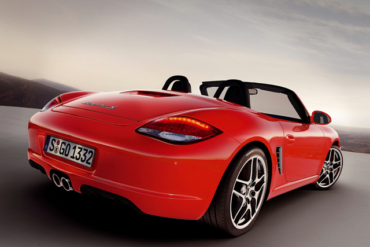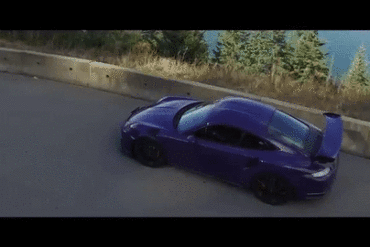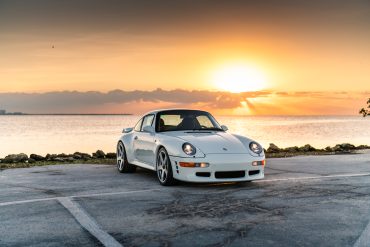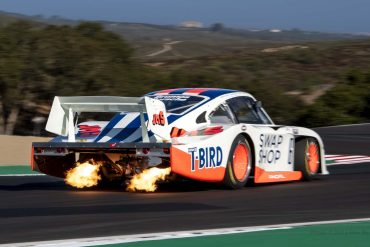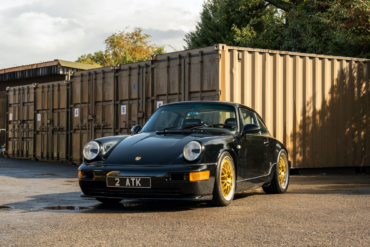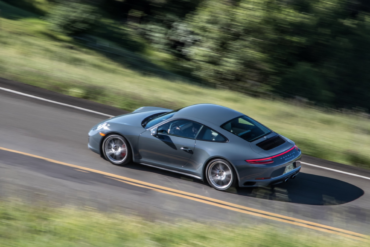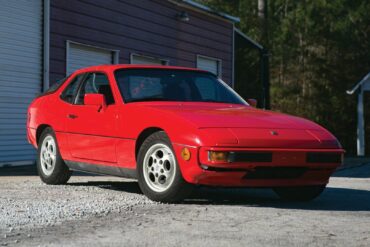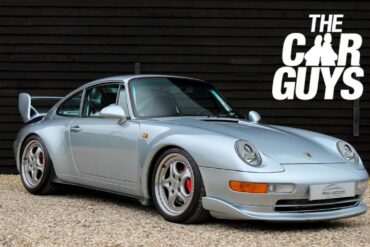The Panamera 4S Executive is just a 'stretched-out' version of the regular Panamera sedan. The wheelbase has been lengthened by as much as 15 centimetres, an increase that mostly benefits the rear passengers. The Panamera 4S Executive sits above the Panamera 4 Executive, and they share several similarities, such as the panoramic sunroof, heated rear seats and power sunblind in the rear. Style-wise, the Panamera 4S Executive also boasts silver accents around the fenders and side skirts.
Porsche Models
All
- Porsche Cayman 987 (2nd Gen)
- Porsche 924
- Porsche Cayenne 955 (1st Gen)
- Porsche Cayenne
- Porsche Carrera GT
- Porsche Boxster Concept
- Porsche 911
- Porsche 959
- Porsche 944
- Porsche 928
- Porsche 962
- Porsche RS Spyder
- Porsche 917K
- Porsche 914
- Porsche 918
- Porsche Cayman 981 (3rd Gen)
- Porsche Cayenne 957 (1st Gen)
- Porsche Boxster 986 (1st Gen)
- Porsche Boxster 987 (2nd Gen)
- Porsche 718 Cayman 982 (4th Gen)
- Porsche Cayenne 958 (2nd Gen)
- Porsche 356 Pre-A
- Porsche Boxster 981 (3rd Gen)
- Porsche 356 A
- Porsche 718 Boxster 982 (4th Gen)
- Porsche 356 B
- Porsche 356 C
- Porsche 968
- Porsche Panamera
- Porsche Panamera 970 (1st Gen)
- Porsche Panamera 971 (2nd Gen)
- Porsche Boxster
- Porsche Cayman
- Porsche Macan
- Porsche Taycan
- Porsche 912
- Porsche 919
- Porsche 956
- Porsche 2708 Indy
- Porsche Type 64
- Porsche 918 RSR Concept
- Porsche 918 Spyder
- Porsche 918 Concept
- Porsche 918 Spyder Prototype
- Porsche 917
- Porsche Race Cars
- 911 Carrera RS 2.7
- Porsche 550
- Porsche 718
- Porsche 901 (911)
- Porsche Concept Cars
- Porsche 904
- Porsche 906
- Porsche 907
- Porsche 908
- Porsche 910
- Porsche 911 (F-Series)
- Porsche 911 (991)
- Porsche 911 (G-Series)
- Porsche 911 (964)
- Porsche 911 (993)
- Porsche 911 GT1 Race
- Porsche 911 GT1 Street
- Porsche 911 (996)
- Porsche 911 (997)
- Porsche 916
- Porsche 919 Hybrid
- Porsche 934
- Porsche 934/5
- Porsche 935
- Porsche 936
- Porsche Mission E
- Porsche 928
- Porsche 928 S
- Porsche 928 S4
- Porsche 928 GT
- 911 Speedster Concept
- Porsche 928 GTS
- Porsche 928 Specials
- Porsche 928 H50
- Porsche 935 Tribute
- Porsche 928 CS/SE
- Porsche 597
- Porsche Mission E Cross Turismo
- Porsche 551
- Porsche Concept 917
- Porsche 911 (992)
- Porsche Sport Tourer Electric
- Porsche Le Mans Living Legend
- Porsche 960 Turismo Concept
- Porsche 919 Street
- Porsche 904 Living Legend
- Porsche 906 Living Legend
- Porsche 911 Vision Safari Concept
- Porsche Bergspyder Concept
- Porsche Macan Vision Safari
- Porsche Vision 916
- Porsche Vision 918 RS
- Porsche Vision 920
- Porsche Vision E
- Porsche 917 16-Cylinder Prototype
- Porsche 959 Gruppe B
- Porsche Carrera GT Concept
- Porsche Tapiro Concept
- 718 Cayman GT4 Rallye
- Porsche Taycan 4S
- Porsche Taycan Turbo
- Porsche Taycan Turbo S
- Porsche Typ 360
- Porsche 645 Spyder
- Porsche 550 Coupé (Prototype)
- Porsche 550 Spyder (Prototype)
- Porsche 550 Spyder
- Porsche 550 RS Spyder
- Porsche 550A RS Spyder
- Porsche 787 F1
- Porsche 804 F1
- Porsche 904 Carrera GTS
- Porsche 904/6 Carrera GTS
- Porsche 904/8 Carrera GTS
- Porsche 904 Bergspyder
- Porsche 906 Spyder
- Porsche 906 LH Coupé
- Porsche 965 (911)
- Porsche 942
- Porsche 906 E Carrera 6
- Porsche 959 Prototype
- Porsche 906/8 Coupé
- Porsche 969
- Porsche 906 Carrera 6
- Porsche 989
- Porsche 910 Bergspyder
- Porsche 910 Targa
- Porsche 909
- Porsche C88
- Porsche Panamericana
- Porsche 718 RSK Spyder
- Porsche 718 RS 60 Spyder
- Porsche 718 RS 61 Spyder
- Porsche 718 W-RS Spyder
- Porsche 718 GTR Coupe
- Porsche 718/2 F2
- Porsche 718 RS 61 LM Coupé
- Porsche 718 RSK Mittellenker
- Porsche 907 K
- Porsche 907 LH
- Porsche 908/01 LH Coupé
- Porsche 908/01 K Coupé
- Porsche 908/02 K Spyder
- Porsche 908 K Flunder Spyder
- Porsche 908 LH Flunder Spyder
- Porsche 908/03 Spyder
- Porsche 908/03 Spyder Turbo
- Porsche 919 Hybrid Evo
- Porsche LMP2000
- Porsche 984
- Porsche LMP1-98
- Porsche 961
- Porsche 917 LH-69
- Porsche WSC-95
- Porsche 917 K-69
- Porsche 917 ‘Interserie Spyder’
- Porsche 917 K-70
- Porsche 917 K-71
- Porsche 917 LH-70
- Porsche 917 LH-71
- Porsche 917/20
- Porsche 917/10-71
- Porsche 917/10-72
- Porsche 917/10 Turbo
- Porsche 917/20 Turbo
- Porsche 917/30
- Porsche 914/4 (1.7 L)
- Porsche 914/4 (2.0 L)
- Porsche 914/6 (2.0 L)
- Porsche 914 LE
- Porsche 914/4 (1.8 L)
- Porsche 914/8
- Porsche 914-6 GT
- Porsche 924 (Base)
- Porsche 924 Turbo
- Porsche 924 Carrera GT
- Porsche 924 Carrera GTR
- Porsche 924 Carrera GTS
- Porsche 924S
- Porsche 924 Rallye Turbo
- Porsche 924 Carrera GTP
- Porsche 924 SCCA
- Porsche 944 Coupe
- Porsche 944 S Coupe
- Porsche 944 S2 Coupe
- Porsche 944 S2 Cabriolet
- Porsche 944 Turbo Coupe
- Porsche 944 Turbo S Coupe
- Porsche 944 Turbo Cup
- Porsche 944 Turbo Cabriolet
- Porsche 944 GTP
- Porsche 944 Swiss Special
- Porsche 944 French Special
- Porsche 944 Celebration
- Porsche 944 S2SE
- Porsche 968 Coupe
- Porsche 968 Cabriolet
- Porsche 968 CS Coupe
- Porsche 968 Turbo S
- Porsche 968 Turbo RS
- Porsche 968 Sport
- Porsche 959 Rally
- Porsche 959 Komfort
- Porsche Cayenne 9YA (3rd Gen)
- Porsche 959 Sport
- Porsche Boxster (Base)
- Porsche Boxster S
- Porsche Boxster S Special Edition
- Porsche Boxster Spyder
- Porsche Boxster RS 60 Spyder
- Porsche Boxster GTS
- Porsche Boxster T
- Porsche Cayman (Base)
- Porsche Cayman S
- Porsche Cayman GTS
- Porsche Cayman GT4
- Porsche Panamera Sport Turismo
- Porsche Cayman R
- Porsche Macan 95B (1st Gen)
- Porsche Cayman S Black Edition
- Porsche Macan (Base)
- Porsche Cayman S Sport
- Porsche Macan S
- Porsche Cayman S Design Edition 1
- Porsche Macan GTS
- Porsche Cayman T
- Porsche Macan Turbo
- Porsche Taycan (Base)
- Porsche Cayman GT4 Clubsport
- Porsche Taycan 4
- Porsche 718 Boxster 25
- Porsche Formula E
- 964 Carrera 2
- 964 Carrera 4
- ’30 Jahre’ Anniversary
- 964 Speedster
- 964 Turbo
- 964 Carrera RS
- 964 Carrera Cup
- 964 RSR
- Porsche Cayman GT4 RS
- 993 Carrera
- 993 Carrera 4
- 911 Edition 50
- 911 2.0 Bertone Roadster
- 993 Carrera 4S
- Porsche Macan T
- Porsche Mission R Electric
- 993 Carrera S
- 993 Targa
- Porsche Vision Gran Turismo
- 992 Sport Classic
- 993 Turbo
- 993 Carrera RS
- 996 Carrera
- 993 GT2
- 996 Carrera 4
- 992 America Edition 911
- 993 Carrera Cup
- 996 Targa
- 996 Carrera 4S
- Porsche 963
- 996 Turbo
- Porsche 718 Cayman GT4 ePerformance
- 996 Turbo S
- 996 GT3
- 996 GT3 RS
- 996 GT2
- 718 Boxster
- 996 GT3 Cup
- 996 GT3 R
- 996 GT3 RSR
- 997 Carrera
- 996 GT3 RS Race
- Porsche 991 (991)
- 997 Carrera S
- 997 Carrera 4
- 997 Carrera 4S
- 997 Targa
- 911 Carrera 3.0 Coupe (G-Series)
- 997 Targa 4S
- 997 Turbo
- 997 Turbo S
- 997 GT2
- 992 Carrera T
- 997 GT2 RS
- 997 Speedster
- 997 Carrera GTS
- 992 Dakar
- 997 Carrera 4 GTS
- 997 GT3 Cup
- 997 GT3 R
- 997 GT3 RSR
- 997 GT3
- 997 GT3 RS
- 997 GT3 R Hybrid
- 991 Carrera
- 991 Carrera 4
- 991 Carrera S
- 991 Carrera 4S
- Porsche 981
- Porsche Vision 357
- 991 Targa 4
- 991 Targa 4S
- 991 Turbo
- 991 Turbo S
- 991 Carrera GTS
- 991 Carrera 4 GTS
- 991 Targa 4 GTS
- Porsche 961
- 991 911 R
- 991 GT3
- Porsche 992 GT2 RS
- 991 GT3 RS
- 991 GT2 RS
- 991 Speedster
- 991 GT3 R
- 991 GT3 Cup
- 991 RSR
- Porsche 962
- 991 Carrera T
- Porsche Cayenne (4th gen)
- 992 Carrera 2
- 992 Carrera 4
- Porsche Type 540 America Roadster
- Porsche 718 Spyder RS
- 992 Carrera S
- 992 Carrera 4S
- 992 Targa 4
- 992 RSR
- 992 Targa 4S
- Porsche Mission X
- 992 Carrera GTS
- 992 Carrera 4 GTS
- 992 Targa 4 GTS
- Porsche RS60 Spyder
- 992 Turbo
- 992 GT3 R
- 992 Turbo S
- 992 GT3
- 992 911 S/T
- 992 GT3 Touring
- 911 (G-Series)
- 992 GT3 RS
- 992 GT2 RS
- 911 Carrera 3.0 (G-Series)
- 992 GT3 Cup
- Porsche Taycan GTS
- Porsche 356 SC
- 911 S (G-Series)
- Porsche Mission X
- 911 SC (G-Series)
- Porsche 992 GT3 R Rennsport
- 911 Carrera RSR 2.8
- 911 S/T
- 911 (Base Model)
- 911 Carrera 3.2 (G-Series)
- 911 SC Safari
- 911 L
- 911 Turbo (930)
- 911 T
- 911 Carrera RSR Turbo 2.1
- 911 Carrera RSR 3.0
- 911 E
- 911 SC San Remo
- 911 S
- Pre-A Speedster
- 911 R
- Porsche 953
- Porsche 356
- 911 Carrera 3.2 Clubsport
- Porsche Panamera (3rd gen)
- 911 SC RS
- 911 Carrera 25th Anniversary
- 911 T/R
- 911 Turbo LE
- 911 Carrera RS 3.0
- Beutler Coupe
- 911 Turbo 2.7
- 911 Carrera 2.7 (G-Series)
- 911 3.2 Speedster
- 911 Carrera Commemorative
- Porsche 911 GT1
- Porsche 99X Electric
- Porsche Macan 4
- 964 Turbo S
- Taycan Turbo GT
This 1975 Porsche 911S Coupe underwent an extensive restoration project. The car’s bodywork was chemically stripped and sandblasted, and various...
2023 Porsche 911 Dakar (992) Technical Specifications Tech Specs Model 992 911 Dakar Production Units 2500 (limited) Motor Bore 102.0...
Porsche 944 History & Story The predecessor, the 924, was initially designed for Volkswagen. It was beautifully done by Porsche and...
Porsche 914 Tune Up Specifications Valve Clearance with engine cold Description 1700cc 4-Cylinder 1800cc 4-Cylinder 2000cc 4-Cylinder 2000cc 6-Cylinder Intake...
Porsche introduced a new wide-body package option. Known as the M491 option it was commonly known as the "Turbo-Look". It gave the naturally aspirated cars the look and style of the 930 Turbo with wide wheel arches and the distinctive "tea tray" tail. It wasn't just about looks however, because M491 also got you the stiffer suspension shared with the Turbo and the superior Turbo braking system as well as the wider Turbo wheels. It was available on the Coupe, Cab and Targa.
The rear-wheel drive and naturally aspirated 4.8-litre V8 make the first Panamera S a great all around passenger car with sports car energy. The Porsche Panamera 4S is an all wheel drive vehicle, with its engine placed in the front, and a 4 door saloon (sedan) body. The Porsche Panamera 4S belongs to the 970 range of cars from Porsche. Power is supplied by a double overhead camshaft, 4.8 litre naturally aspirated 8 cylinder motor.
Porsche 959 Coupé (only 292 models produced in 1988 in order to obtain Group B racing homologation), 6-cylinder boxer turbo,...
The Porsche 911 GT2 RS MR | Chris Harris Drives The Porsche 911 GT2 RS Manthey Racing has a long...
2023 Porsche 911 Sport Classic (992) Pictures & Gallery ...
A handful of push-rod 356As were delivered from the factory with a lightweight package that was usually reserved for the Carrera race cars. Called GTs, these got the stripped out interior, aluminum doors, a large fuel tank and Porsche ATE disc brakes. As few as four Speedsters came equipped this way. Since the four-cam was only a marginal improvement in power, the regular 1600 Super was more than enough for the small car.
1973 Porsche 914/6 Video Review This 1973 Porsche 914-6 was the owner, Marco’s car when he was in high school,...
POV in a Manual 718 Cayman GTS 4.0...
Reviewed and edited by Rex McAfee The legend of Porsche 907 K 025 Imagine a race victory so popular at...
The Kaege Retro Turbo is based on a Porsche 993 Turbo. It offers all-wheel drive and more than 450 hp!...
An exclusive limited edition Cayenne GTS “Porsche Design Edition 3”. Limited to just 1,000 units worldwide, the limited edition Cayenne adds equipment and Porsche Design styling touches to stand out from the crowd. Distinguishing the special edition model is a Lava Grey paint scheme, extended roof spoiler, racing stripes, and 21in alloy wheels in a matching anthracite finish. This special edition looks the goods, but sadly there were no mechanical changes to differentiate it from the core GTS.
At Porsche, the “GTS” designation—short for Gran Turismo Sport—signifies enhanced dynamism and long-distance performance. The Cayenne fundamentally embodies the dual...
Porsche 911 (997) Transmission Codes The transmission number code is found on the transmission data plate. Code Transmission Model years...
The 993 Carrera Cup 3.8 was developed from the 993 Carrera RS, as purpose-built competition car designed by Porsche for its single-model racing series taking place around the world. Replacing the 964 Carrera Cup, the 993 Carrera Cup had a claimed 315 bhp on tap, weighed only 1,100kg, and offered a top speed of around 270km/h (170mph). Approximately 216 samples were built. The Carrera Cup should not be confused witth the Carrera RSR, or the 993 Carrera RS Clubsport version.
AutoTopNL POV Drive in a 718 Boxster...
The Porsche Penske Motorsport works team and the winner of 53 Formula 1 Grands Prix, Sebastian Vettel, are looking forward...
Based as they are on the 300-hp V-6 Panamera and Panamera 4, the Platinum Edition is available with either rear- or all-wheel drive. Outside, the cars are separated from standard V-6 Panameras by platinum silver metallic trim. The shiny stuff covers the grille and rear diffuser accents, the lower half of the side mirrors, and the trunk trim. Porsche also throws in a set of 19-inch Turbo wheels and finishes the window trim in gloss black. A sport design steering wheel is standard, as well as Porsche crests on the front and rear headrests and “Platinum Edition” lettering on the doorsill trim.
8 minutes of Porsche 356 goodness British Touring Car runner-up Sam Tordoff had quite the time in the Fordwater Trophy...
Porsche Option Codes – 2009 Cayman Looking to decode your 2009 Porsche Cayman option codes? Want to know what those...
1968 Porsche 911 T/R Pictures & Gallery ...
Porsche Option Codes – 2013 Cayman Looking to decode your 2013 Porsche Cayman option codes? Want to know what those...
1951 – 1953 Porsche 356/1300 Split-Window Cabriolet (Pre-A) Technical Specifications Type Series Production Car Production Years 1951 – 1953 Built...
In the world of automotive enthusiasts, the fusion of history, engineering, and art often leads to extraordinary creations. One such...
Not Even Close? We all know the Porsche 918 Spyder is quick, but is it faster than a MotoGP bike?...
(2017-2019) Porsche 911 RSR (991) Technical Specifications Technical data Porsche 911 RSR model year 2017 Concept Single-seater race car for...
In 1993, the 964 Turbo introduced an entirely new engine configuration to critical acclaim. The engine’s displacement was increased to...
In the latest video from Porsche, we have British professional tennis player, Emma Raducanu taking a Porsche 911 GT3 for...
The Puerto Rico Commission stared out as a US-market 964 Carrera 2 that has been disassembled and rebuilt with a...
Porsche also came to surprise everyone with them dropping the curtains of their newest Cayenne, which now happens to bear...
Porsche 906 Carrera 6 Specifications Specs 906 Coupé (homologation model) 906 coupe Engine: 6-cylinder boxer engine (four-stroke) 6-cylinder boxer engine...
2022 Porsche 911 Carrera 4 GTS (992) Technical Specifications Model 911 Carrera 4 GTS Design and cylinders Twin-turbo boxer 6 Number...
2003 Porsche 911 Carrera Cabriolet (996.2) Technical Specifications Engine Type Flat 6 Induction Normally-aspirated Cooling Water-cooled Valvetrain Double overhead camshafts...
The first iteration of the Porsche Cayman GT4 made its debut in 2015, drawing a conclusion to the third generation...
Porsche 911 997 Turbo PDK Review Today I’m driving Scott’s 911 997 Turbo. This car is equipped with the tiptonic...
Video Review Porsche Taycan Turbo S The most exciting Porsche model right now is easily the Taycan Turbo S. Sure...
Porsche Option Codes – 2007 Boxster Looking to decode your 2007 Porsche Boxster option codes? Want to know what those...
Porsche 911 (997) (2004 – 2012) Story & History Type 997 – The 6th Generation Porsche 911 Official photos: 2004...
Singer Vehicle Design – Fredericksburg Commission Today, we take a closer look at the Singer Vehicle Designs Fredericksburg Commission. The...
2004 Porsche 911 Carrera 4S Cabriolet (996) Technical Specifications Engine Type Flat 6 Induction Normally-aspirated Cooling Water-cooled Valvetrain Double overhead...
3rd Generation Porsche Boxster (981) Story & History Boxster 981 (2013 – 2016) Official photos: 2012 January 12, GTS 2014...
2012 – 2015 Porsche 911 Carrera S Pictures & Gallery...
2012 Porsche 911 Turbo S Cabriolet (997) Technical Specifications Engine Type Flat 6 Induction Twin-turbocharged Cooling Water-cooled Valvetrain Double overhead camshafts...
2004 Porsche 911 Carrera Cabriolet (996.2) Technical Specifications Engine Type Flat 6 Induction Normally-aspirated Cooling Water-cooled Valvetrain Double overhead camshafts...
We’ve mentioned the Theon Design ITA001 already, the first Italian commission-built Porsche 964-based carbon fiber bodied beauty that packs 400...
The combination of Porsche’s cornerstone flat-4 air-cooled engine (from the model 356) with a more modern 911 chassis is what...
2001 Porsche Boxster Technical Specifications Engine Type Flat 6 Induction Normally-aspirated Cooling Water-cooled Valvetrain Double overhead camshafts Injection Port injection...
The biggest change for the 2013 Panamera S was under the hood, where a twin-turbo 3.0-liter V6 engine was installed. It replaced the older 4.8-liter naturally aspirated unit. It was a win-win combination since it offered 20 hp more and it was more fuel-efficient. Unlike its predecessor, it was available exclusively with a 7-speed automatic (PDK – dual-clutch). The all-wheel-drive system was carried over, but the final drive was different to allow better fuel-efficiency.
Bring A Trailer is currently auctioning a 2019 Porsche 911 GT3 RS that comes with the highly sought-after and expensive...
The last iteration of the 944 Turbo was the 944 Turbo Cabriolet which was the 944 Turbo Cabriolet. This was a 944 Turbo S with a special cabriolet body made by the American Sunroof Company (ASC) of Weinsberg, Germany, who also made the bodies for the 944 S2 Cabriolet. 625 of the 944 Turbo Cabriolet were made with 100 being built with right hand drive and the remaining 525 being left hand drive.
Is The 997 GT2 Really a $170k Experience? Based on the 997 Turbo, the GT2 was by the far the...
In 1988, Porsche unveiled the “Commemorative Edition” Carrera (also called the Jubilee Edition) to celebration the 250,000th 911. Porsche built...
Prepare for a showdown between two vehicles that will surely pique your interest! The contenders are a Porsche Cayenne and...
Porsche 911 Turbo S Review By Evo The Porsche 911 Turbo S boasts 572bhp and manages 0-62mph in 2.9 seconds....
The Story of the Porsche 924 The Porsche 924, 944, and 968 were never meant to be Porsches. This lineup...
2020 Porsche 718 Cayman T (982) Technical Specifications Engine Type Flat 4 Induction Turbocharged Cooling Water-cooled Valvetrain Double overhead camshafts...
Doug DeMuro recently fulfilled his dream of owning a Porsche Carrera GT and shared an update on his YouTube channel....
The Carrera S convertible was introduced to the market at the same time with the Carrera Cabriolet, a few months after their coupe-versions were unveiled. The convertible version for the Carrera S got reinforcements needed for the cabriolet built while the engineering was going on for the coupe, ensuring that the drop-top version was just as strong and performance-focused. It got the same engine as the Carrera S and made a case for itself as the best 911 of the range at the time.
Porsche 550 RS Spyder Specifications Starting with Chassis 550-03 (the third Porsche 550 prototype), Porsche gave the 550 the latest...
The Porsche 914-6 GT was a race car built by Porsche, based on the 914 model with a 6-cylinder engine and GT package. The 914-6 GT was a race configured version of the 914-6. The factory offered the GT option, which was distinguishable by its box-like steel fender flares. It quickly became known as the 914-6 GT and was raced employing different engine configurations. This included the 'T' specification, which was a basic 911 engine. Another popular configuration was to use a converted Carrera 6 engine.
The Porsche 962 arrived on scene in 1984 as essentially a Porsche 956 for the IMSA/US market. A biturbo version was used in competition racing in Europe, while an IMSA version with a turbocharger featured in North America. The 962 C was based on the 956, with a 120 millimetre longer wheelbase and competed in LeMans. It differed from the IMSA version. The driver trio Stuck/Bell/Holbert was victorious at Le Mans in 1987. Porsche offered the 962 to privateers to race on their own and they were hugely successful.
The Porsche 911 GT2 combines the sporting character of the 996 911 GT3 with the power and straight line performance of...
The Porsche 960 Vision Turismo is a mid-size sedan concept, designed and built by Porsche in 2016 that previewed some of the future design cues that Porsche would incorporate into the Porsche 911 (generation 991.2). The creation of the concept happened nearly by accident when somebody saw a sketch of the 918 Spyder and thought it had four doors .
This 993-generation Porsche 911 coupe was modified by renowned Porsche tuner Akira Nakai, who fitted it with a 17-piece RWB...
In a new video, Magnus Walker interviews Charles Lennon, a dentist from New Jersey, who is also the proud owner...
Nordschleife Hot Lap In A Porsche 964 RS vs. 992 Carrera S Porsche 911 Carrera RS (964), Porsche 911 Carrera...
Porsche 924 Spare Parts Catalogs (1980 – 1985 Model Year) These official Porsche PET Diagrams and codes for the Porsche...
When Ulrich Bez returned from BMW to Porsche to become its technical board director in October 1988, he found a...
2021 Porsche 718 Boxster T (982) Technical Specifications Engine Type Flat 4 Induction Turbocharged Cooling Water-cooled Valvetrain Double overhead camshafts...
Collecting Cars is currently offering a 1957 Porsche 356 A Speedster that was purchased and owned for 50 years by...
There are currently two notable Porsche 911s being offered on Bring a Trailer: a 1965 Porsche 911 and a 2006...
Porsche 908 K Flunder Spyder Specifications type Racing Car built at Germany engine Boxer-8 position Mid Longitudinal aspiration Natural valvetrain...
1964 – 1965 Porsche 356 C 1600C Coupe Technical Specifications Model Years 1964 – 1965 Built At Stuttgart, Germany Engine...
The 2012 Porsche Boxster S – /CHRIS HARRIS ON CARS Porsche’s new 981 Boxster is an all-new design. Bigger, but...
2022 Porsche 718 Boxster (982) Technical Specifications Engine Type Flat 4 Induction Turbocharged Cooling Water-cooled Valvetrain Double overhead camshafts Injection...
Porsche Type 64 Specifications The Porsche type 64 KdF Berlin-Rome car is acknowledged as the original ancestor of all the...
Arguably the most extreme 911 to be build as a production car for the road and track. The most significant...
Today Porsche revealed two new versions of their popular mid-engine 718 models, for the 2023 model year we’ll be getting...
1990 Porsche 911 Carrera 2 Coupe (964) Technical Specifications Engine Type Flat 6 Induction Normally-aspirated Cooling Air/oil-cooled Valvetrain Single overhead...
2010 Porsche Cayman S Technical Specifications Engine Type Flat 6 Induction Normally-aspirated Cooling Water-cooled Valvetrain Double overhead camshafts Injection Port...
First look at Gunther Werks’ customer specced Ruby Schemed Remastered Turbo. Photo Source: Gunther Werks...
1991 Koenig-Specials C62 One of the more notorious tuners is Koenig Specials. As the focus of the company has been...
Join Nick as he talks about the difference between a regular Porsche 911 992 GT3 and a GT3 Touring....
The Porsche 911 Carrera 3.0, which was produced for only 2 years in 1976 and 1977, is a very special...
1972 – 1973 Porsche 911 S 2.4 Coupe (LWB) Pictures & Gallery...
The 944 range officially ended production in July 1991. A dated range and slow sales wrote the obituary for the model, but in the UK, brand-new cars still languished at dealers well into 1993. A UK-only special edition was made in 1992 and it was called the Porsche 944 S2 SE. It was basically an S2 brought up to full specification, for less than the standard car. Very limited, only 15 were eventually made. Benefits listed include improved acceleration in higher rev range; flatter cornering due to stiffer springs and increased roll resistance...
Porsche Taycan World Premiere on September 4 at 9 am And so the future begins. Porsche’s Taycan will be one...
2011 Porsche Boxster S Technical Specifications Engine Type Flat 6 Induction Normally-aspirated Cooling Water-cooled Valvetrain Double overhead camshafts Injection Direct...
A Must-Have Car For All People Who Just Love to Drive, the “Porsche 911 GT3 RS” If Lamborghinis are meant...
Starting as a modest service station in Pfaffenhausen, Germany, within a mere three decades, RUF quickly evolved into a hub...
After what felt like an eternity for Porsche enthusiasts, the seventh “family affair” of monumental proportions kicked off on the...
Porsche decided to build the 1993 Carrera RS both to European spec and a limited number in compliance with US...
2016 – 2019 Porsche 911 Carrera 4S Coupe (991.2) Pictures & Gallery...
Porsche Option Codes – Porsche 924 (1988 Model Year) Looking to decode your 1988 Porsche 924 option codes? Want to...
This week Jason takes a trip down to Ashgood Classic and Sports Cars to test drive an iconic Porsche, the...


